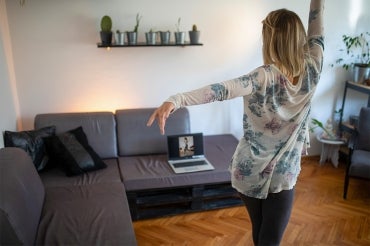U of T dance course gets students off their feet and choreographing across time zones

(Photo by Andrija Nikolic/iStockPhoto)
Published: May 25, 2021
Singing in a choir, performing with an orchestra, working out – these have all been done remotely since the beginning of the COVID-19 pandemic.
Now, undergraduate students at the University of Toronto have choreographed dances while oceans apart. In the course on the theory of dance performance in the Faculty of Kinesiology and Physical Education, students explored essential elements of dance, including staging, lighting and show production, in the run-up to their major project in which they get to stage their own dance piece.
Tanya Berg, the course instructor, says the students overcame technical challenges, like camera positioning, as well as personal ones, including nervousness.
“I admire their resilience and perseverance to learn new physical skills while on camera,” she says. “The connection established between the students in this class cannot be overstated in a socially distanced term. During physical isolation and over multiple countries, dance brought these students together online for creative projects providing hours of supportive communication and fun physical activity.”
While all students collaborated on their final projects remotely, one group worked across different time zones.
Third-year kinesiology student Artie Yao went back to China at the onset of the pandemic to be with his family. Despite a 13-hour time difference between Toronto and Zhengzhou, where his family lives, Yao stayed up late every Monday to participate in the course synchronously.
“Even though our instructor provided us with course recordings and recommended we sleep and watch them in the morning, I still chose to stay up late every Monday to follow the class live, because that’s how I learn best,” he says.
It wasn’t all smooth sailing. With class warm-ups starting at midnight Zhengzhou time, Yao sometimes accidentally woke up his parents.
“My mom wanted me to drop the course,” he says with a laugh. From then on, he tried to keep the volume down when he practised for the course.
For their final project, Yao’s group worked on a piece they called “Dance in the Pandemic.”
“Since the lockdowns started, everyone has been affected mentally and physically,” he says. “People have been losing jobs, worrying about school, caring for their families, missing social interactions, feeling upset and hopeless.
“But, everything has two sides and we wanted to see the bright side of the pandemic and cheer people up.”
In their video, the group dances in unison and solo to an upbeat song encouraging viewers to stay safe and healthy, acknowledging their frustrations with the pandemic and reminding them that they’re not alone.
For Yao, who’s been dancing since grade eight, the biggest lesson has been that everyone can dance.
“People sometimes say they can’t dance, but that’s not true,” he says. “Dr. Berg and her guests taught us that we should dance with our feelings. They never asked us to mimic their movements because we’re all at different levels, but also because dance welcomes everyone.”
With 13 years of dance experience, fourth-year kinesiology student Brittany Wu took the course because she was hoping to get a deeper appreciation for one of her greatest passions.
“I sought to further my understanding of the physical experience of dance, the science of dance, dance history and show production,” she says.
Although learning remotely presented challenges, Wu appreciates Berg’s efforts to facilitate a smooth learning experience.
“Dr. Berg and the guest choreographers adapted all the choreography taught in the course so that it could be performed in spaces of all sizes and types,” says Wu. “Dancers performed in their kitchens, basements and sometimes even outdoors. This taught me that dancing can extend beyond a studio space.”
Wu’s group focused on the mental health ramifications of the COVID-19 pandemic and the resilience and fortitude that people demonstrated in response.
“This project was unlike any other,” she says. “It allowed us to utilize the power of dance and physical movement to work through difficult emotions that we had all been experiencing in artistic, creative and meaningful ways.”
With a mix of experienced and novice dancers in each group, the students met weekly to assist the beginners and ensure they were comfortable with the choreography.
“This experience taught me that anything is possible with a little creativity, adaptability and perseverance,” says Wu.


